2018-2019学年高二英语人教版选修9Unit 4 Exploring plants 4.1 PPT课件
- 格式:pptx
- 大小:378.70 KB
- 文档页数:28
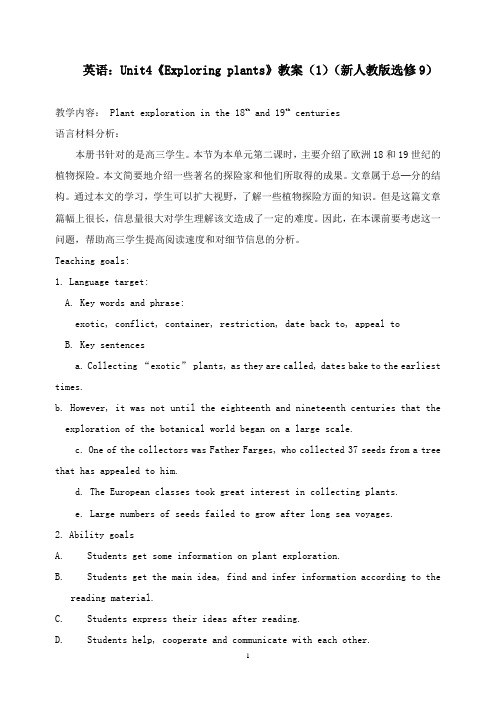
英语:Unit4《Exploring plants》教案(1)(新人教版选修9)教学内容: Plant exploration in the 18th and 19th centuries语言材料分析:本册书针对的是高三学生。
本节为本单元第二课时,主要介绍了欧洲18和19世纪的植物探险。
本文简要地介绍一些著名的探险家和他们所取得的成果。
文章属于总─分的结构。
通过本文的学习,学生可以扩大视野,了解一些植物探险方面的知识。
但是这篇文章篇幅上很长,信息量很大对学生理解该文造成了一定的难度。
因此,在本课前要考虑这一问题,帮助高三学生提高阅读速度和对细节信息的分析。
Teaching goals:nguage target:A. Key words and phrase:exotic, conflict, container, restriction, date back to, appeal toB. Key sentencesa. Collecting “exotic” plants, as they are called, dates bake to the earliest times.b. However, it was not until the eighteenth and nineteenth centuries that the exploration of the botanical world began on a large scale.c. One of the collectors was Father Farges, who collected 37 seeds from a tree that has appealed to him.d. The European classes took great interest in collecting plants.e. Large numbers of seeds failed to grow after long sea voyages.2.Ability goalsA.Students get some information on plant exploration.B.Students get the main idea, find and infer information according to thereading material.C.Students express their ideas after reading.D.Students help, cooperate and communicate with each other.Teaching important pointsTo enable students to understand the reading material by using predicting, skimming, scanning, analyzing, summarizing and inferring after reading.Teaching difficult points1. To enable students make use of given information to express their opinions on the passage.2. Help students observe language points and prepare for the grammar revision.Teaching methodsTask-based learning approach, competition, group work, discussionTeaching aidsMulti-media computer platform, group cardsTeaching proceduresStep 1. Lead-in (3’)A. Divide the whole class into small groups.B. A video clipFocus: To arouse students’ interest and give the task to students.Step 2. Pre-reading (3’)Predict according to the title.The author may tell us _____ in this passage.A. some plants from other countriesB. the events happening in plant explorationC. how to explore plantsD. famous plant collectorsFocus: Students can make prediction after observing the title carefully.Step 3. While readingPart 1. Fast readingRead for the main idea and solve the task given in pre- reading. (Students work in groups and work out the questions).Part 2. Detailed reading (20’)(Students write down the words, phrases and sentences they can’t understand and work in groups to solve them and work out the multiple choices questions). Task 1. Scanning1. Plant collectors met many difficulties except_______.A. diseases and near-starvationB. the conflicts with local peopleC. restrictions on the movement of EuropeansD. lack of money2. Who is not a collector mentioned in the passage?A. Father d’Incarville.B. The Queen of England.C. Robert Fortune.D. E H Wilson.3. The following plants were taken to Europe except_______.A. the tree of HeavenB. the Dove TreeC. the tea plants4.The first recorded plant exploration happened _______.A. in the 18th centuryB. about 1500 years agoC. about 3500 years agoD. about 2500 years agoFocus: To develop students’ ability to search for detailed information.Task 2. Analyzing1. The passage is organized in the order of ______.A. timeB. placeC. characterFocus: To develop students’ ability to analyze the whole passage.Task 3. Inference1. What do you think the author will talk about if he adds a paragraph to this passage?A.The effects of the plant exploration in the 18th and 19th centuries.B. The plant exploration in the 20th century.rmation about the Dove Tree.Focus: To help students read beyond the reading material and make their own judgment according the reading material.Task 4. Language observation1. What is the meaning of the underlined part in the sentence “One of thecollectors was Father Farge, who collected 37 seeds from a tree that had appealed to him”?A. that surprised himB. that he had never seen beforeC. that attracted himD. that he thought was very valuable2. The earliest record of plant exploration in history dates from 1500 BC. The earliest record of plant exploration in history ____ ____ ____1500 BC.3. People didn’t begin to explore plants on a large scale until the 18th and 19th centuries.It was ____ ____ the 18th and 19th centuries that people began to exploreplants on a large scale.4. The parts in red are used as______ in the sentences.A. the subjectB. the objectC. the predicative1.He collected seeds of trees.2. French Catholic missionaries were beginning to set themselves up in China.3. The European classes took great interest in collecting plants.4. Large numbers of seeds failed to grow after long sea voyages.5. … often we do not realise that many of them come from countries far away. Focus: To help students infer the meanings according to the context.To help students observe the feature of the object and prepare for the grammar learningStep 4. Post-readingHelp Liang Qiming find out who made the greatest contribution in plant exploration in the 18th and 19th centuries.1.Discussing in groups2.Giving opinions.Step 5. Assignments1.Try to add a short paragraph as the end of the passage.2. Get some information about plant exploration in the 20th and 21st centuries on the Internet.。
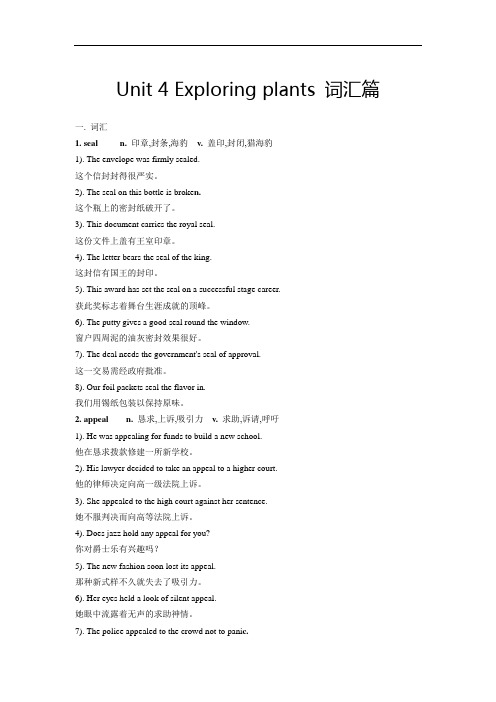
Unit 4 Exploring plants 词汇篇一. 词汇1. seal n.印章,封条,海豹v.盖印,封闭,猎海豹1). The envelope was firmly sealed.这个信封封得很严实。
2). The seal on this bottle is broke n.这个瓶上的密封纸破开了。
3). This document carries the royal seal.这份文件上盖有王室印章。
4). The letter bears the seal of the king.这封信有国王的封印。
5). This award has set the seal on a successful stage career.获此奖标志着舞台生涯成就的顶峰。
6). The putty gives a good seal round the window.窗户四周泥的油灰密封效果很好。
7). The deal needs the government's seal of approval.这一交易需经政府批准。
8). Our foil packets seal the flavor in.我们用锡纸包装以保持原味。
2. appeal n.恳求,上诉,吸引力v.求助,诉请,呼吁1). He was appealing for funds to build a new school.他在恳求拨款修建一所新学校。
2). His lawyer decided to take an appeal to a higher court.他的律师决定向高一级法院上诉。
3). She appealed to the high court against her sentence.她不服判决而向高等法院上诉。
4). Does jazz hold any appeal for you?你对爵士乐有兴趣吗?5). The new fashion soon lost its appeal.那种新式样不久就失去了吸引力。
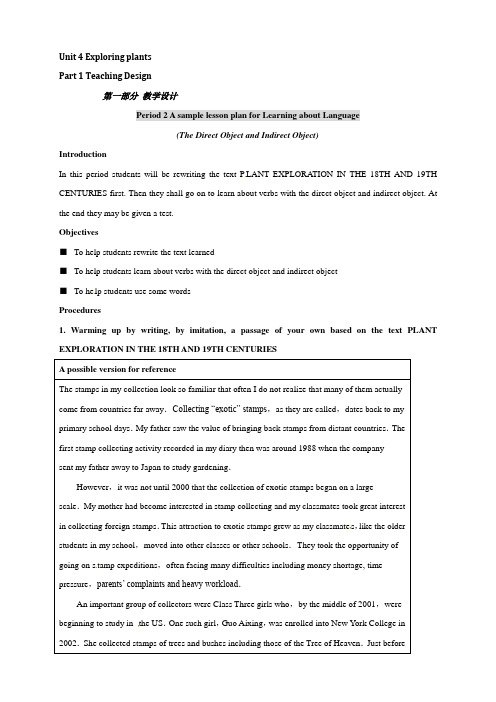
Unit 4 Exploring plantsPart 1 Teaching Design第一部分教学设计Period 2 A sample lesson plan for Learning about Language(The Direct Object and Indirect Object)IntroductionIn this period students will be rewriting the text P LANT EXPLORA TION IN THE 18TH AND 19TH CENTURIES first. Then they shall go on to learn about verbs with the direct object and indirect object. At the end they may be given a test.Objectives■To help students rewrite the text learned■To help students learn about verbs with the direct object and indirect object■To he lp students use some wordsProcedures1. Warming up by writing, by imitation, a passage of your own based on the text PLANT EXPLORATION IN THE 18TH AND 19TH CENTURIESThis attraction to exotic stamps grew as my classmate stamp expeditionsthe US2. Discovering useful words and expressionsDo plants grow better if you talk to them? I don’t know.Now let’s go to page 34 to skim the two exercises text to get an over vi ew of what are being talked about.Go to page 32 to scan the text for words and expressions to complete the two exercises on page 34. 3. Learning about verbs with the direct object and indirect object当及物动词有两个宾语时,两个之间有些无须介词,有些则需要。
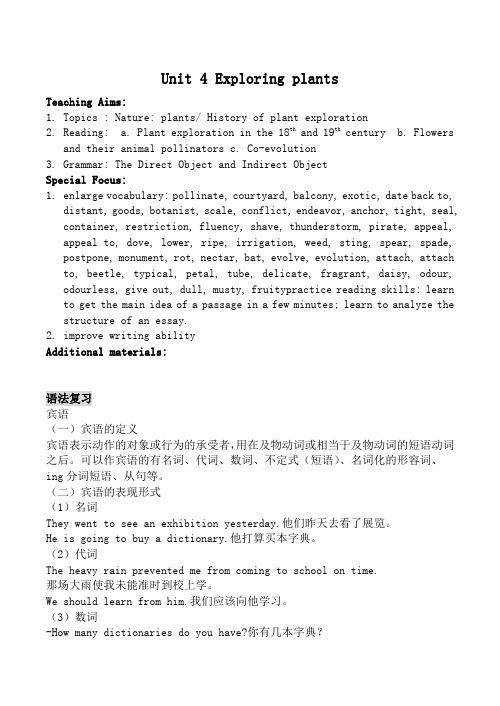
Unit 4 Exploring plantsTeaching Aims:1.Topics : Nature: plants/ History of plant exploration2.Reading: a. Plant exploration in the 18th and 19th century b. Flowersand their animal pollinators c. Co-evolution3.Grammar: The Direct Object and Indirect ObjectSpecial Focus:1.enlarge vocabulary: pollinate, courtyard, balcony, exotic, date back to,distant, goods, botanist, scale, conflict, endeavor, anchor, tight, seal, container, restriction, fluency, shave, thunderstorm, pirate, appeal, appeal to, dove, lower, ripe, irrigation, weed, sting, spear, spade, postpone, monument, rot, nectar, bat, evolve, evolution, attach, attach to, beetle, typical, petal, tube, delicate, fragrant, daisy, odour, odourless, give out, dull, musty, fruitypractice reading skills: learn to get the main idea of a passage in a few minutes; learn to analyze the structure of an essay.2.improve writing abilityAdditional materials:语法复习宾语(一)宾语的定义宾语表示动作的对象或行为的承受者,用在及物动词或相当于及物动词的短语动词之后。
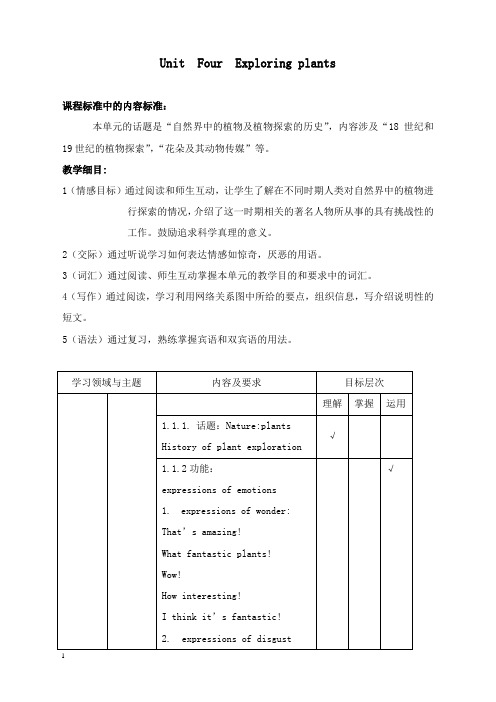
Unit Four Exploring plants课程标准中的内容标准:本单元的话题是“自然界中的植物及植物探索的历史”,内容涉及“18世纪和19世纪的植物探索”,“花朵及其动物传媒”等。
教学细目:1(情感目标)通过阅读和师生互动,让学生了解在不同时期人类对自然界中的植物进行探索的情况,介绍了这一时期相关的著名人物所从事的具有挑战性的工作。
鼓励追求科学真理的意义。
2(交际)通过听说学习如何表达情感如惊奇,厌恶的用语。
3(词汇)通过阅读、师生互动掌握本单元的教学目的和要求中的词汇。
4(写作)通过阅读,学习利用网络关系图中所给的要点,组织信息,写介绍说明性的短文。
5(语法)通过复习,熟练掌握宾语和双宾语的用法。
Part One单元重点知识点I. 重点单词和词组P. 31Words: courtyard, balconyPhrases: adjust toP. 32Words: exotic, distant, goods, scale, conflict, missionary, endeavour, anchor, tight, seal, portable, containerPhrases: date back to, send away, bring back, become interested in, set...up, comeacross, large numbers of,P. 33Words: restriction, fluency, shave, botanistPhrases: appeal to, be excited with, a variety ofP. 34Words: lower, beardPhrases: result in,P. 35Words: ripe, irrigation, weed, string, postpone, pyramid, monumentP. 36Words: pitcher,P. 37Words: rot, pollinatorP. 38Words: evolve, evolution, nectar, wasp, beetle, bat, moth, typical, petal, tube, delicate, fragrant, daisy, odorless, dull, musty, fruity Phrases: take place, adapt to, depend on, give outII. 重点句型见表1.1.7III. 重点语法复习非限制性定语从句:能理解非限制性定语从句的意义和功能,能正确区分限制性定语从句和非限制性定语从句的区别,从而正确使用非限制性定语从句。

Unit 4 Exploring plantsPart 2 Teaching Resources第二部分教学资源Section 2 Notes to difficult sentences from Unit 4Exploring plants1.Collecting “exotic” plants,as they are called,dates back to the earliest times.收集“异国”植物,人们这样称呼他们,可以追溯到远古时期。
句中as they are called是非限制性定语从句,as是关系代词,起连接作用,同时作从句中的主语补语。
请看关系代词as的其它例句:I received the same grade as you did. Those as want to can come with me. I received the same grade as you did. Those as want to can come with me. 2.However,it was not until the eighteenth and nineteenth centuries that the exploration ofthe botanical world began on a large scale.然而,直到十八、十九世纪植物学世界的探险活动才开始大规模进行。
句中it was not until…that…意思是:在...以前一直(不...),...以后才。
例如:It was not until he was thirty that he started to paint. 他直到三十岁才开始绘画。
3.Large numbers of seeds failed to grow after long sea voyages or trips across land between Asia and Europe. 大量的种子在跨越亚洲和欧洲之后没能成功地生长。
Unit 4 Exploring plantsPeriod oneAim:To train the students’ ability of listening and speaking.Contents:Step I Warming upQ1 What do you know about plants?Q2 Do you know what kind of plant don’t have flowers?Q3 Do you know what kind of plant have roots that live in the air?Q4 Do you know what kind of plant need animals to pollinate them?Q5 Do you know what kind of plant grow on other plants?Q6 Do you know that people buy plants that come from other countries for their gardens?Q7 Do you know that a new plant does not always grow from a seed?Step II Listen and discuss:First give some photos of the plants and then ask students answer the following question.(Page 38)Q1 How would you describe each plant?Q2 What do you think is unusual about each plant?Q3 One of the pictures shows pitcher plants and another shows “Living stones”which picture shows which plant?Now listen to Mark,Gordon and Andrea telling their class about these plants.Which students talk about which plants?Listen again and complete the table with the correct information.Period twoAim:To make students understand the text.Plant exploring in the 18th And 19th centuries.Contents:Q1 What is each paragraph about?Q2 Write down the topic of each paragraph in your own words.Q3 What happened in these years? Complete the sentences on page 33.Q4 Answer there question in groups.1) Why was there a lot of plant collecting in the 18th and 19th centuries?2) How did French missionaries come to be plant collection?3) What were some of the negative aspects of plant collecting expeditions?4) Transporting plants over long distances was a big problem, why was this?5) Why did many plants fail to reach their destinations alive? Can you thinkof any other reasons?6) What important the survival rates of plants transported long distances? 0Period threeAim:To make students master the language points in this text.Contents:Phrases:1 date back to: go back to/date fromeg: This town dates back to the Rome time2 on a large scale3 take / find/ have/ show/ find interest in.4 take the opportunity of doing sth5 go on botanical expeditions6 come into conflicts withbe in conflicts with7 accompany sb: keep sb company8 on purpose / by design / by intentionwith the purpose of9 come acrossrun into / acrossmeet with10 keep sth alive11 make a trip to .12 dress as13 in…style14 result inlead tobring about15 be excited with16 have a vast variety of17 n ot only…but alsonot alone…but alsonot merely/ simply… but alsoA as well as BA andB as well18 distant adj. far away in space or time 远的,遥远的19 distance n. in the distancefrom the distanceat a distancekeep sb. a distance20 scale n. 1) balance for weighing磅秤2) relative size, extent, scope规模,程度on a large / small scale大/小规模on the scale of … to…按…的比例to a scale按一定比例to a scale of … to…按…的比例21 appeal to 1)恳求,恳请I am appealing on behalf of the refugees.我代表那些难民提出恳求He appeal to us for help.他恳求我们的帮助2)诉诸,诉之于Appeal to the law / a higher court3)事物引起(人的)兴趣,有吸引力,投入所为Does the film appeal to you?n. make an appeal to 吸引, 诉之于Sentence structures1.It was not until the eighteenth and nineteenth centuries that the explorationof the botanical world began on a large scale.2.Not only did Fortune introduce over 120 species of plants to western gardensbut he also shipped 20000 tea plants from…Period FourAim:To make students understand the textFlowers and their animal pollinatorsContents:I. Questions:1)What is the text about?2)What do the pictures show you?3)What is the chart about?4)What is the advantage for animal of visiting flowers?5)Who do some plants need animals?6)How does an animal pollinate a flower?7)What is nectar?8)What kinds of animals are most flowers pollinated by?II. Language points1.over time 随着时间的推移over the weekend 整个周末里over these years 在这些年里2.reward sb with sth用…回报某人3.attach… to依附于…上4.pass on to把…往下传5.adapt to 使…适应The spokesman adapts his speech to suit the interests of his audience.He has adapted to the climate here.6.describe … as 把…描述成7.guide sb to .把…领到…nd on 登陆9.provide sb. with sth向…提供provide sth for sb.provide for 养活,规定III. Difficult sentences1)Pollen becomes attached to the animals during its visit to a flower and is thenpassed on to another plant’s blossom on its next visit.动物接触一朵花后,花粉就附着在它身上,动物接触下一种植物的花时就把这些花粉传到花朵上.2)Through evolution, most flowers have become adapted to attract specific typesof pollinators.通过进化,大部分花朵变得适于吸引特殊种类的花粉传播者.。
Unit 4 Exploring plantsPart 2 Teaching Resources第二部分教学资源Section 1 Backgrounds f or Unit 4 Exploring plants1.Importance of PlantsPlants form the basic food staple for all life forms. They a re the major source of food and oxygen on earth, since no animal can supply these necessary components without p lants. Th e cattle we eat as beef, feed on grasses and the fish we eat, consume algae and are therefore dependen t on plants for well being. Other important uses of plants include, providing shelter for animals, providing materials for clothing (cotton fibers), paper products, medicines and other chemicals, producing coal from once living plant materi al, reducing wind speed and noise level s, and reducing soil erosion and water runoff.2. The life cycle of a plantThe life cycle of a plant varies depending on the individual species. There are, however, certain requirements for life that most plants need. The growth of a plant is dependent upon light, water, oxygen, car bo n dioxide, minerals in the soil, temperature and microbes in the soil. Light, water, and carbon dioxide are needed for photosynthesis which produces food for the plant. Oxygen is needed when it is dark, because the plant then needs oxygen to maintain itself.。